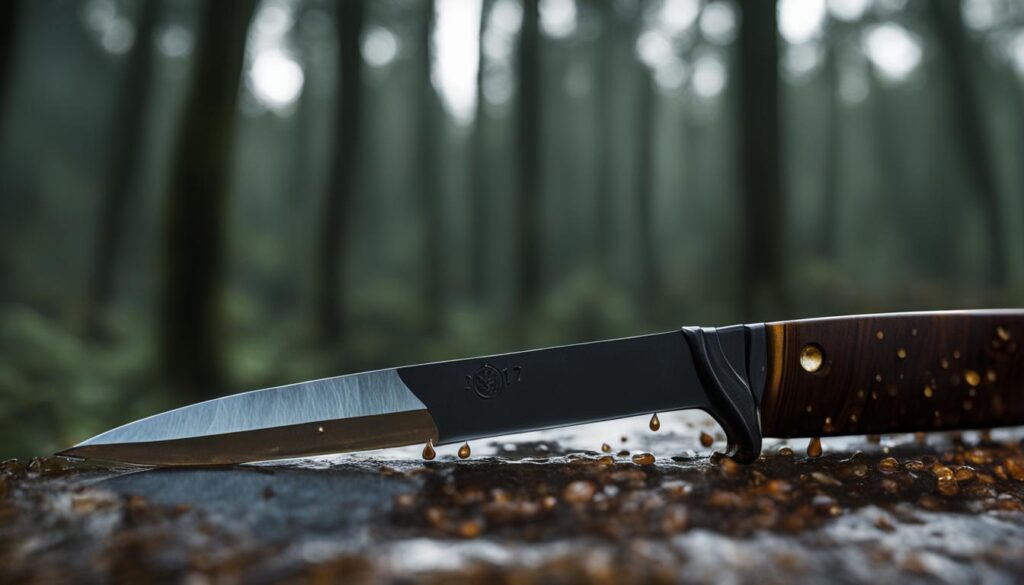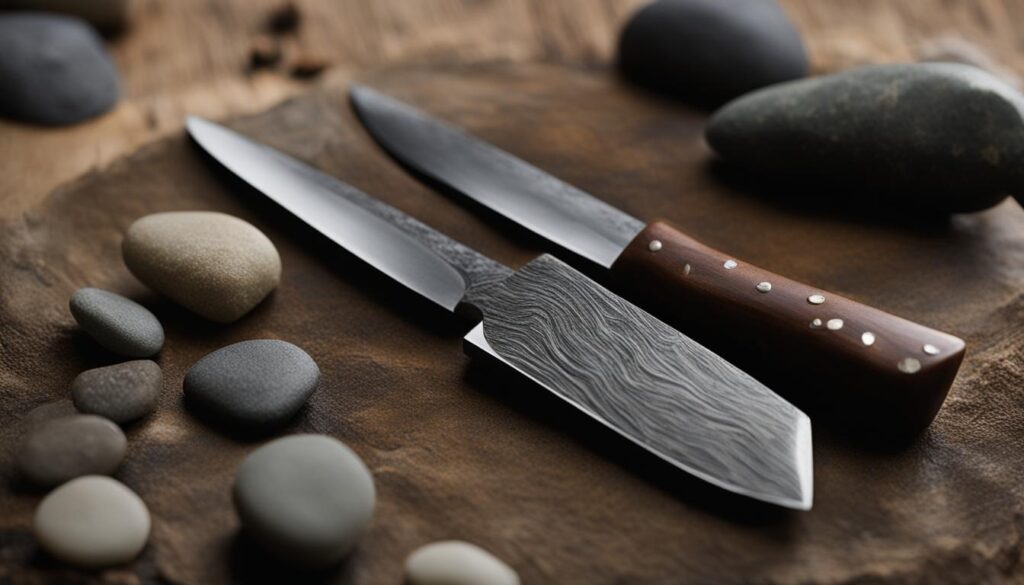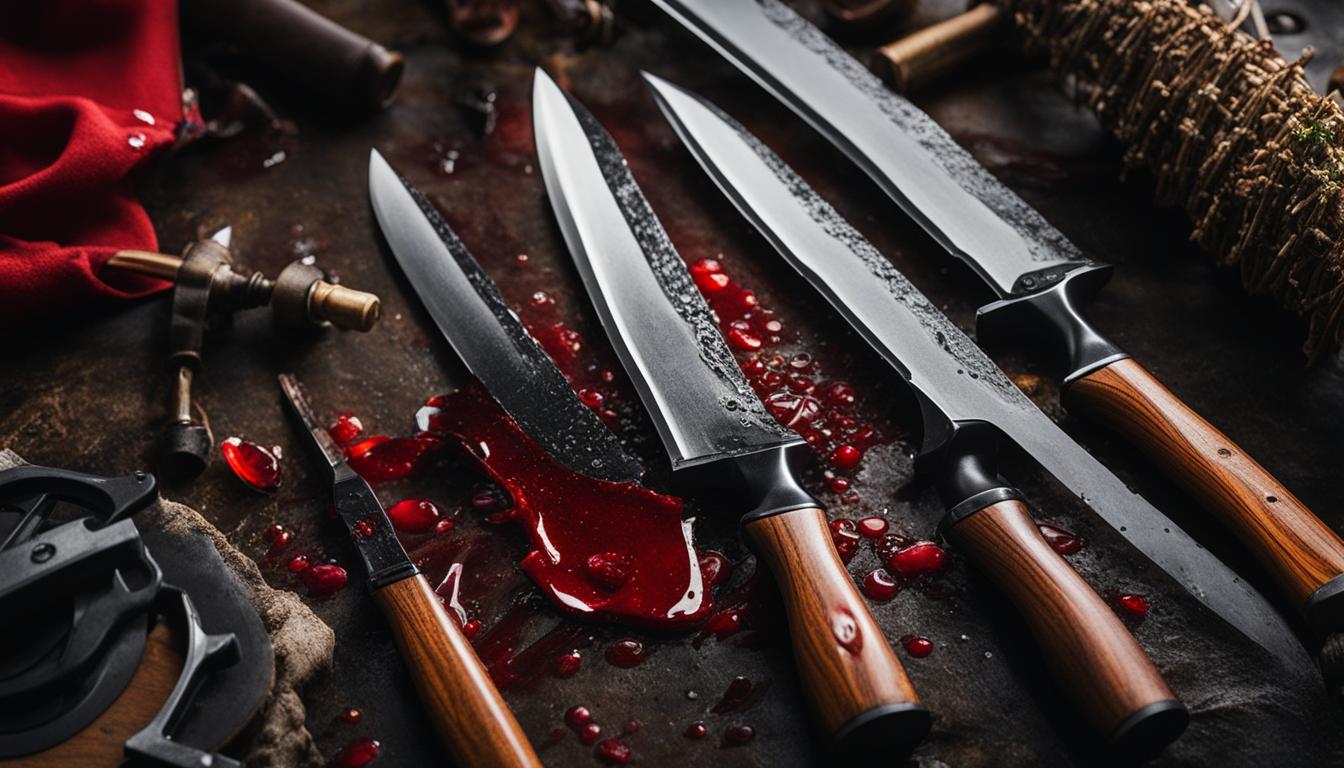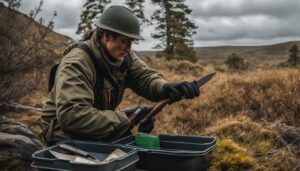Knives are essential tools for hunters, and proper maintenance is crucial to ensure safety in the hunting field. As a hunter myself, I understand the importance of keeping my knife in top condition to avoid any accidents or mishaps.
When it comes to knife maintenance for safety, there are a few key tips that every hunter should follow. By implementing these practices, you can ensure the safe use of your knife during hunting activities:
1. Always handle your knife with care. Treat it as a valuable tool and avoid reckless or careless handling.
2. Use a razor-sharp knife. A sharp knife requires less force, reducing the chances of slips and accidents.
3. Use the right knife for the job. Different knives are designed for specific tasks, so using the appropriate one will enhance both your efficiency and safety.
4. Cut away from your body. This simple rule can prevent potentially serious injuries if the knife were to slip unexpectedly.
5. Never run with a knife in your hands. Running with a knife increases the risk of accidents and should be avoided at all costs.
6. Only use a knife in a well-lit area. Proper lighting allows you to see what you’re doing and decreases the likelihood of accidents.
Remember, these tips are just the beginning. Proper knife maintenance is an ongoing process that should be prioritized. By taking care of your knife, you’ll not only improve its performance but also ensure your safety while out in the hunting field.
Key Takeaways:
- Handle your knife with care to avoid accidents and injuries.
- Keep your knife razor-sharp for efficient and safe cutting.
- Choose the right knife for the task at hand to enhance both performance and safety.
- Always cut away from your body to prevent potential injuries.
- Avoid running with a knife to reduce the risk of accidents.
The Importance of Keeping Your Knife Sharp
A sharp knife is essential for safe and efficient cutting in the hunting field. When a knife is dull, it requires more force to cut through materials, increasing the risk of slips and accidents. To ensure your knife remains sharp and ready for use, regular maintenance is crucial.
Sharpening your knife with a whetstone or sharpening system is recommended. This process involves removing a small amount of metal from the blade’s edge to create a fine, sharp edge. To test the blade’s sharpness, gently run your finger along the edge or try slicing into a piece of paper. If it glides effortlessly, your knife is properly sharpened.
Remember, a sharp knife is a safe knife.
By keeping your knife sharp, you not only enhance its cutting performance but also reduce the risk of accidents caused by slips and excessive force. Maintaining a sharp knife is an essential part of knife safety and care.
Benefits of a Sharp Knife
There are several benefits to keeping your knife sharp:
- Efficient cutting: A sharp knife requires less effort to cut through materials, making your tasks easier and more efficient.
- Precision and control: With a sharp knife, you can achieve cleaner and more precise cuts, giving you better control over your actions.
- Reduced risk of accidents: A sharp knife reduces the need for excessive force, decreasing the likelihood of slips, mishaps, and injuries.
- Extended blade life: Regular sharpening helps maintain the integrity of the blade, prolonging its lifespan and ensuring consistent performance.
By understanding the importance of keeping your knife sharp, you can prioritize maintenance practices that will enhance your safety and overall hunting experience. Remember, a sharp knife is not only a tool but also a crucial aspect of your safety gear.
Cleaning and Drying Your Knife After Use
Properly cleaning and drying your knife after each use is essential to maintain its safety and longevity. By following a few simple steps, you can ensure that your knife remains in optimal condition and free from rust or damage.
Step 1: Wipe Down the Blade and Handle
Start by wiping down the blade and handle of your knife with a soft cloth. This will remove any debris or residue from the surface, preventing it from becoming embedded or causing corrosion. Take care to clean both sides of the blade and all areas of the handle, including the scales and bolsters.
Step 2: Hand Wash if Necessary
If there are any stubborn messes or stains on your knife, it may be necessary to wash it by hand. Use warm water and a mild dish soap to gently clean the blade and handle. Be sure to avoid soaking the knife or using abrasive materials that could scratch the surface.
Step 3: Thoroughly Dry the Knife
After cleaning, it is crucial to thoroughly dry your knife to remove all moisture. Pay particular attention to areas where water can collect, such as the scales, blade, bolsters, and inside the sheath. Use a clean, dry cloth to carefully dry every part of the knife, ensuring that no dampness remains.
By following these steps, you can keep your knife clean and free from moisture, reducing the risk of rust and damage. Remember to always handle your knife with care and store it properly to maintain its overall safety and performance.
Lubricating and Storing Your Knife
Proper lubrication and storage are key aspects of knife maintenance for safety and longevity. By regularly lubricating your knife and storing it correctly, you can prevent rust, corrosion, and other forms of damage. Here are some essential tips for keeping your knife in optimal condition:
- Choose the right lubricant: When it comes to lubricating your knife, using the right oil is crucial. Gun or knife oil is recommended as it is designed to protect metal surfaces from moisture and corrosion. Apply the oil sparingly to pivot points, blade hinges, and any other areas that may be prone to friction.
- Pay attention to handle materials: If your knife has a handle made of natural materials like wood or bone, it’s important to apply oil to these surfaces as well. This helps prevent drying, cracking, and warping of the handle.
- Store your knife in a dry place: Moisture is the enemy of knives, as it can lead to rust and other forms of damage. It’s best to store your knife in a dry area, away from sources of humidity and moisture. Avoid leaving your knife in a sheath for extended periods, as moisture can accumulate and cause corrosion.
- Avoid extreme temperature fluctuations: Temperature swings can also impact the condition of your knife. Avoid storing it in areas with extreme heat or cold, as this can affect the blade’s hardness and overall performance.
- Protect your sheath: If your knife has a sheath, consider using a protectant to make it more resistant to water and moisture. This can help prolong the life of the sheath and ensure better protection for your knife during storage and transportation.
By following these simple tips, you can ensure that your knife is well-lubricated, protected, and ready for use whenever you need it. Taking the time to properly maintain and store your knife will not only extend its lifespan but also contribute to your overall safety and the performance of your hunting tools.

Proper Sharpening Techniques
Ensuring that your knife is properly sharpened is an essential part of knife maintenance for safety. When it comes to sharpening your knife, it is important to consider the sharpening angle based on the blade grind. Different blade grinds require different angles to achieve optimal sharpness. For example, hollow grinds typically require wider angles, while flat grinds require narrower angles.
To determine the correct sharpening angle for your knife, consult the manufacturer’s guidelines or do some research online. Once you have the correct angle, use a sharpening stone or sharpening system to sharpen the blade. Start by applying light pressure and running the blade along the stone or system in a consistent motion. Repeat this process on both sides of the blade until you achieve the desired sharpness.
After sharpening your knife, it is important to test the blade’s sharpness. You can do this by running your finger along the edge or slicing into a piece of paper. A properly sharpened knife should glide effortlessly through the paper or cut cleanly with minimal resistance. If the blade is dull or doesn’t perform as expected, it may require further sharpening.
In addition to traditional sharpening methods, using a leather strop can be beneficial for maintaining the sharpness of your knife. A leather strop helps to realign the edge and polish it without removing any metal. This can be particularly useful for maintaining the sharpness of a knife that is already relatively sharp but requires a touch-up.


Summary:
Proper sharpening techniques are essential for maintaining knife safety and cutting performance. Understanding the correct sharpening angle for your knife’s blade grind is crucial. Regularly sharpening your knife using a sharpening stone or system will ensure that it remains sharp and ready for use. Testing the blade’s sharpness and using a leather strop for touch-ups can further enhance the knife’s cutting capabilities. By incorporating these proper sharpening techniques into your knife maintenance routine, you can ensure the safety and effectiveness of your knife during hunting activities.
Conclusion
In conclusion, proper knife maintenance is of utmost importance when it comes to ensuring safety in the hunting field. By following these essential tips, hunters can maintain their knives in optimal condition and minimize the risk of accidents. Handling the knife with care, keeping it sharp, cleaning and drying it after use, lubricating and storing it properly, and using the correct sharpening techniques are all vital steps in maintaining knife safety.
Remember, a sharp knife is a safe knife. Regularly sharpening your knife using the appropriate angle and testing its sharpness will not only enhance cutting performance but also reduce the chances of the knife slipping away from you during use.
Moreover, cleaning your knife after each use and drying it thoroughly will help remove debris and prevent rust. Lubricating your knife with oil, especially in pivot points and natural handle materials, is crucial for preventing corrosion and ensuring its longevity. Storing the knife in a dry place away from extreme temperature fluctuations and direct sunlight is also important to protect it from damage.
Lastly, it is recommended to regularly inspect your knife for wear or damage and have it serviced by a professional if needed. By following these guidelines and maintaining your fixed blade knife properly, you can rely on its safe and reliable performance for many years to come in your hunting pursuits.
FAQ
Why is using a sharp knife important for safety in the hunting field?
Using a sharp knife requires less force and reduces the risk of the knife slipping away from you during cutting tasks, ensuring safer use.
How do I keep my knife sharp?
Regularly sharpen your knife using a whetstone or sharpening system. Test the blade’s sharpness by running your finger along the edge or slicing into a piece of paper.
How should I clean and dry my knife after use?
Wipe down the blade and handle with a soft cloth. For stuck-on messes, wash the knife by hand using warm water and dish soap. Thoroughly dry your knife to prevent moisture damage and rust.
How do I lubricate and store my knife?
Lubricate your knife with oil, such as gun or knife oil, to prevent rust and corrosion. Pay attention to pivot points and natural handle materials. Store your knife in a dry place, avoiding extreme temperature fluctuations and direct sunlight.
What are the proper sharpening techniques?
The sharpening angle depends on the blade grind. Use the correct sharpening angle and test the blade’s sharpness by running your finger along the edge or slicing into a piece of paper. Consider using a leather strop to realign and polish the edge without removing metal.





